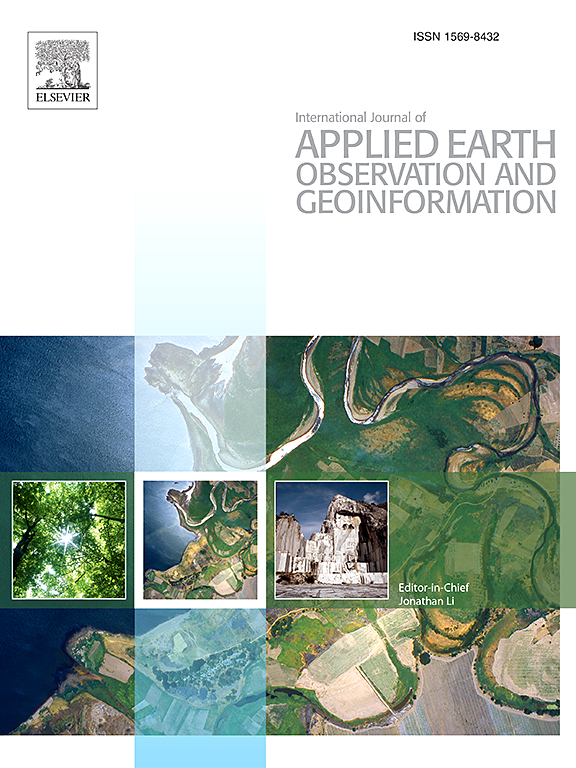利用多源遥感图像绘制十年期荷兰沿海动态地图
IF 7.6
Q1 REMOTE SENSING
International journal of applied earth observation and geoinformation : ITC journal
Pub Date : 2025-03-13
DOI:10.1016/j.jag.2025.104452
引用次数: 0
摘要
滩涂及其相关沙岸是对生态平衡和生物多样性至关重要的动态环境。监测它们的演变历史和地形变化对于更好地了解其动态机制和预测其未来状况非常重要。然而,由于高度动态的水流、悬浮沉积物的变化,以及陆地、滩涂和水域之间界限不清,准确绘制它们的演变图仍然具有挑战性。传统的水线方法在这些条件下难以奏效。在本研究中,我们提出了一种基于对象的图像分割(OBIS)方法,专门用于合成孔径雷达图像,以提取水线并区分滩涂和海岸线与水体。该方法整合了合成孔径雷达极坐标特征分析以选择高质量图像,并采用分区处理以保留局部特征统计数据。利用 199 幅 Sentinel-1 GRD、132 幅 Radarsat-2 SLC 和 157 幅 Landsat 图像,我们分析了荷兰瓦登海从 1986 年到 2020 年的海岸动态。我们的 DEM 根据 LiDAR 数据(2016-2019 年)和 58 个地锚测量站(2011-2020 年)进行了验证,精度达到 10-30 厘米。结果表明,沿海滩涂和沙岸分别以每年 0.107-0.324 平方公里和 0.010-0.073 平方公里的速度扩大,潮间带净体积增加了约 8.6×107 立方米。生成的 DEM 为沉积物预算评估和水动力建模提供了有价值的见解,为科学研究和海岸管理提供了支持。基于 OBIS 的拟议框架证明了其在绘制国家尺度滩涂和沙岸动态图方面的有效性。本文章由计算机程序翻译,如有差异,请以英文原文为准。
Multi-decadal Dutch coastal dynamic mapping with multi-source remote sensing imagery
Tidal flats and their associated sandbanks are dynamic environments crucial for ecological balance and biodiversity. Monitoring their evolutionary history and topographic changes is important to better understand their dynamic mechanisms and predict their future status. Accurately mapping their evolution, however, remains challenging due to highly dynamic currents, suspended sediment variability, and unclear boundaries between land, tidal flats, and water. Traditional waterline methods struggle under these conditions. In this study, we propose an Object-Based Image Segmentation (OBIS) method, specifically designed for SAR images, to extract waterlines and distinguish tidal flats and shorelines from water bodies. This method integrates SAR polarimetric feature analysis to select high-quality images and employs partition processing to preserve local feature statistics. Using 199 Sentinel-1 GRD, 132 Radarsat-2 SLC, and 157 Landsat images, we analyzed coastal dynamics in the Dutch Wadden Sea from 1986 to 2020. Our DEMs, validated against LiDAR data (2016–2019) and 58 ground anchor measuring stations (2011–2020), achieved an accuracy of 10–30 cm. Results show that coastal tidal flats and sandbanks expanded at rates of 0.107–0.324 km yr−1 and 0.010–0.073 km yr−1, respectively, with a net intertidal volume increase of approximately . The generated DEMs provide valuable insights for sediment budget evaluation and hydrodynamic modeling, supporting scientific research and coastal management. The proposed OBIS-based framework demonstrates its effectiveness for mapping national-scale tidal flats and sandbanks dynamics.
求助全文
通过发布文献求助,成功后即可免费获取论文全文。
去求助
来源期刊

International journal of applied earth observation and geoinformation : ITC journal
Global and Planetary Change, Management, Monitoring, Policy and Law, Earth-Surface Processes, Computers in Earth Sciences
CiteScore
12.00
自引率
0.00%
发文量
0
审稿时长
77 days
期刊介绍:
The International Journal of Applied Earth Observation and Geoinformation publishes original papers that utilize earth observation data for natural resource and environmental inventory and management. These data primarily originate from remote sensing platforms, including satellites and aircraft, supplemented by surface and subsurface measurements. Addressing natural resources such as forests, agricultural land, soils, and water, as well as environmental concerns like biodiversity, land degradation, and hazards, the journal explores conceptual and data-driven approaches. It covers geoinformation themes like capturing, databasing, visualization, interpretation, data quality, and spatial uncertainty.
 求助内容:
求助内容: 应助结果提醒方式:
应助结果提醒方式:


